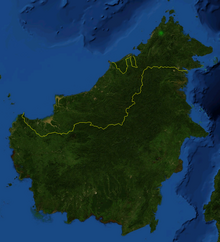Nepenthes x alisaputrana
| Nepenthes × alisaputrana | |
|---|---|
 |
|
| A lower pitcher of N. × alisaputrana | |
| Scientific classification | |
| Kingdom: | Plantae |
| (unranked): | Angiosperms |
| (unranked): | Eudicots |
| (unranked): | Core eudicots |
| Order: | Caryophyllales |
| Family: | Nepenthaceae |
| Genus: | Nepenthes |
| Species: | N. × alisaputrana |
| Binomial name | |
|
Nepenthes × alisaputrana J.H.Adam & Wilcock (1992) |
|
 |
|
| Distribution of N. × alisaputrana. | |
| Synonyms | |
|
|
Nepenthes × alisaputrana (/nᵻˈpɛnθiːz ˈɑːlᵻsəpʊˈtrɑːnə/ preferably, or /əˈlɪsəpʊˈtrɑːnə/, after Datuk Lamri Ali), or the Leopard Pitcher-Plant, is a hybrid of two well-known Nepenthes pitcher plant species: N. burbidgeae and N. rajah. The plant is confined to Mount Kinabalu in Sabah, Borneo.
Nepenthes × alisaputrana was described in 1992 by J. H. Adam and C. C. Wilcock and is named in honour of Datuk Lamri Ali, a former Director of Sabah Parks. It is only known from a few remote localities within Kinabalu National Park, where it grows in stunted, open vegetation over serpentine soils at around 2000 m above sea level, often amongst populations of N. burbidgeae. It grows alongside both parent species on Pig Hill, where it is found at 1930–1950 m.
...
Wikipedia
